
Laban correlated physical efforts with mental efforts, relating Space effort to Attention, Weight to Intention, and Time to Decision. Warren Lamb added shape to this scheme, noting that “We cannot move in making an Effort without an accompanying movement of Shaping.”
The paths traced by the moving parts of the body lie predominately in one of three planes – in the horizontal or table plane, in the vertical or door plane, or in the sagittal or wheel plane. Lamb related these movement patterns to cognitive processes in the following way.… Read More









